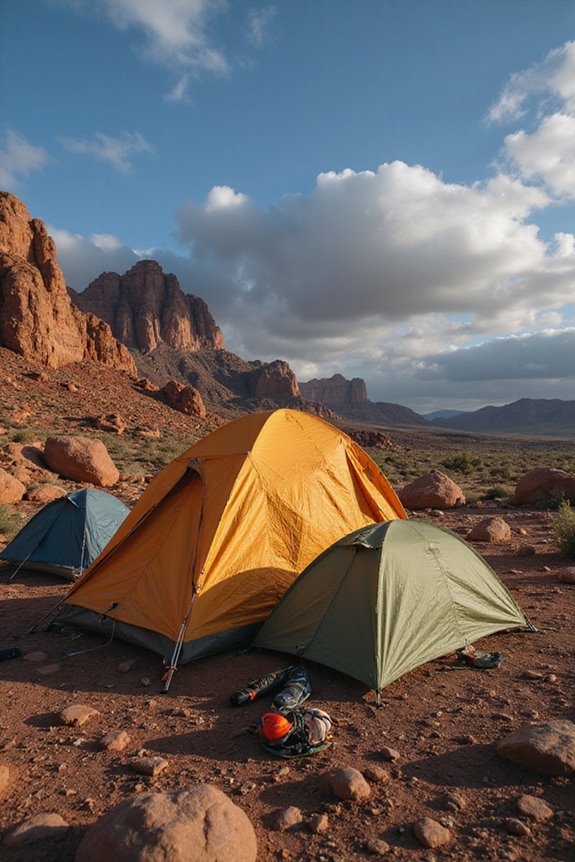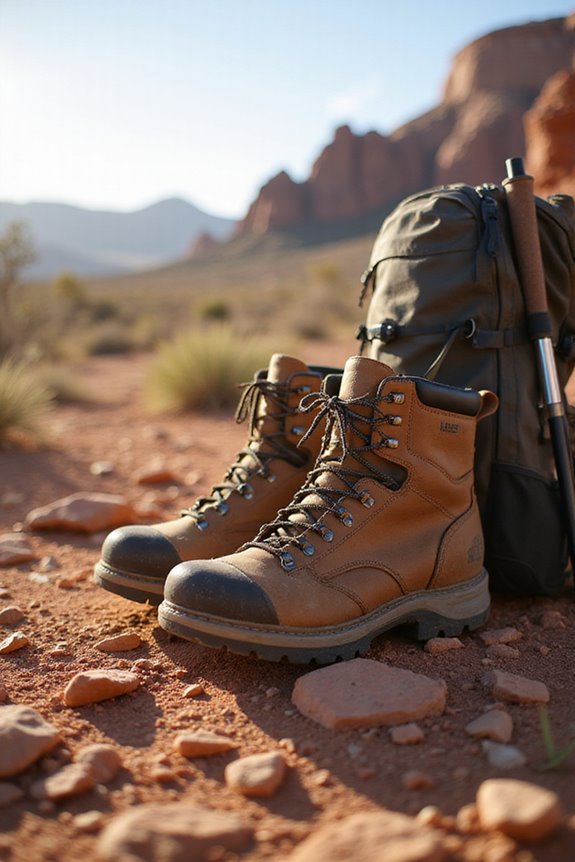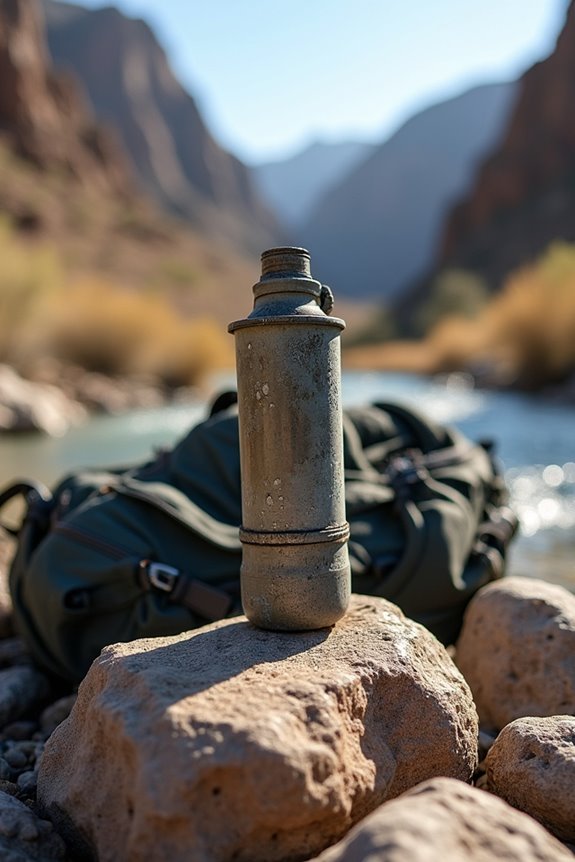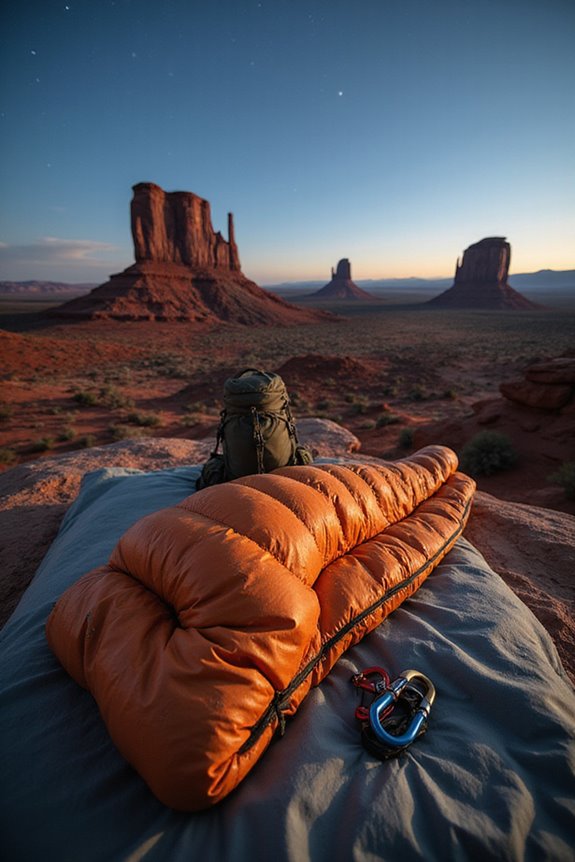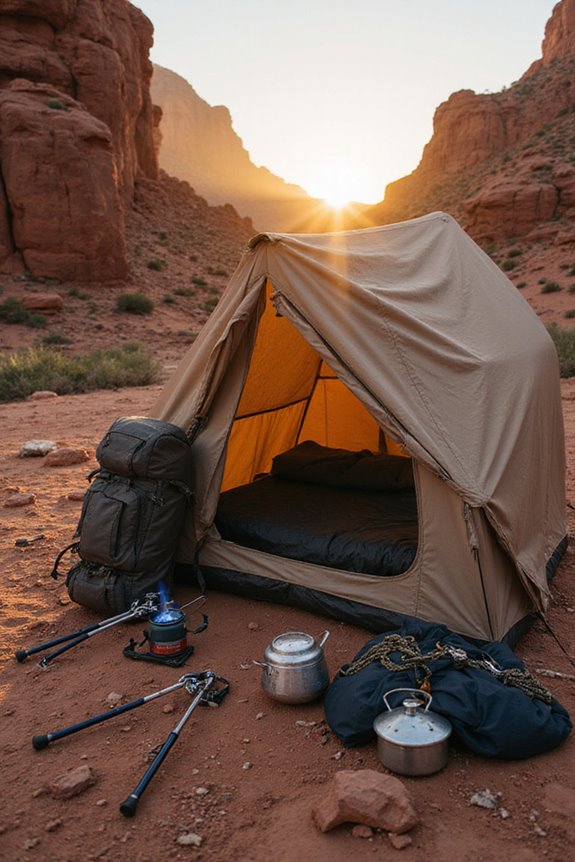Choosing the right tent can be super exciting! We want to think about the type of adventure we’re planning—be it a lightweight dome tent for quick hikes or a spacious tunnel tent for windy campgrounds. Don’t forget to factor in our crew size! Aim for 20 sq.ft. per person for that cozy feeling. And let’s not skimp on materials; it pays off in bad weather. Stick with us and let’s explore more tips to guarantee our camping trips are unforgettable!
Key Takeaways
- Consider the tent type based on your camping needs, such as dome, pop-up, or tunnel tents for specific conditions.
- Choose the appropriate tent size by calculating the number of people and space for gear, aiming for 20 sq.ft. per person.
- Evaluate materials for durability and weather resistance; silicone coatings offer better waterproofing than polyurethane materials.
- Assess weight and portability; ultralight options are best for hiking, while compact packed sizes facilitate transport.
- Look for waterproof ratings suited to your region’s weather, with three-season tents rated between 2,000mm to 3,000mm for versatility.
Understanding Different Types of Tents
When we head out on our camping adventures, choosing the right tent can feel like a monumental task—but it doesn’t have to be! Let’s explore the wonderful world of tent types. For casual outings, dome tents are a favorite; they’re lightweight and provide good ventilation, perfect for comfortable nights under the stars. If speed’s your game, pop-up tents spring into shape, making setup a breeze for backyard fun or summer getaways. For those windy conditions, you might want to reflect on tunnel tents, which offer stability and spacious interiors. Whatever we choose, always think about the tent materials and the camping conditions we’ll face. After all, nothing spoils freedom like a leaky tent on a rainy night!
Determining Tent Size and Capacity

Choosing the right tent size can make or break our camping experience! When we’re diving into tent sizing, let’s keep capacity ratings in mind. Sure, a 2-person tent sounds fun, but if we cram in our gear, it might feel like a clown car! Generally, we should aim for 20 sq.ft. per person for cozy comfort. If we’re camping with a crew, let’s upsize! A 4-person group will enjoy a 6-person tent for gear and wiggle room. And hey, if we’re planning on using air mattresses instead of sleeping bags, we’ll need even more space! Remember, a spacious tent means happier campers. So, let’s make room for memories, gear, and good vibes—freedom awaits under that canvas!
Evaluating Material and Durability
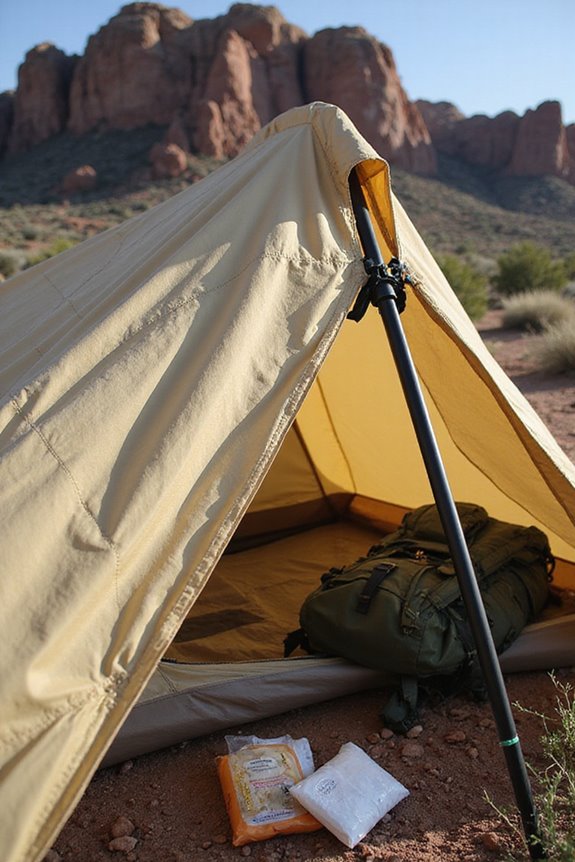
While we often think about a tent’s size, material and durability are just as essential for a successful camping trip. Trust us, nothing ruins a starlit night faster than a soggy shelter! We should look out for tent coatings—silicone is our best buddy for waterproofing and longevity, while polyurethane might let us down over time.
Also, consider fabric breathability; it keeps us cool and dry when the sun beats down. Nylon 6.6 is tough as nails and great for those rugged conditions, while polyester shines with UV resistance. Just remember, investing in quality material can turn any camping adventure into an unforgettable experience—let’s choose wisely and roam freely!
Considering Weight and Portability
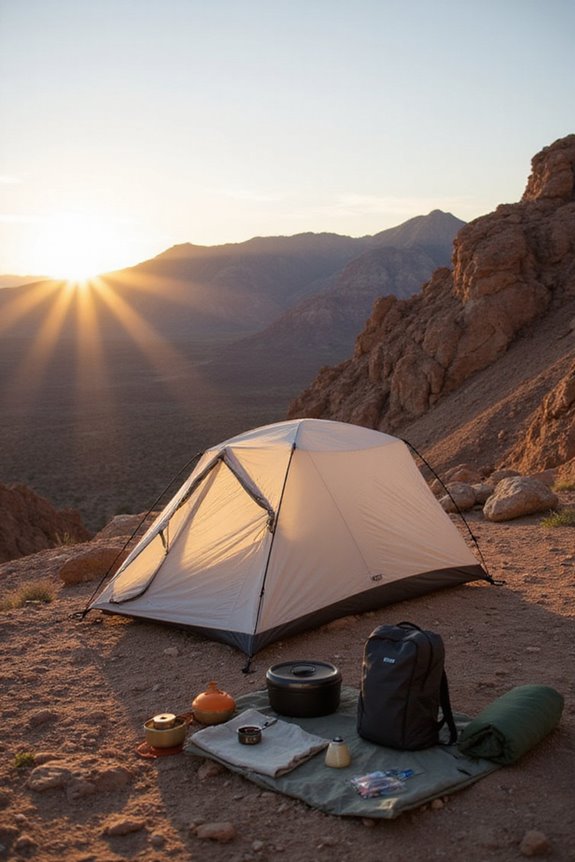
As we gear up for our next outdoor adventure, it’s crucial to think about weight and portability—after all, every ounce counts on the trail! When we’re hiking long distances, ultralight options that weigh around 2 pounds can make a world of difference. Imagine breezing through those miles without feeling pinned down by a hefty tent!
Packed size is just as important. A smaller packed volume means we can easily fit our tent into our backpacks, leaving room for other essentials. And let’s not forget about those clever carrying systems, like stuff sacks, that help us stay organized and minimize bulk. Trust me, once we’re out there, we’ll be grateful for lightweight, portable gear that lets us enjoy the freedom of the great outdoors!
Assessing Weather Resistance and Seasonality
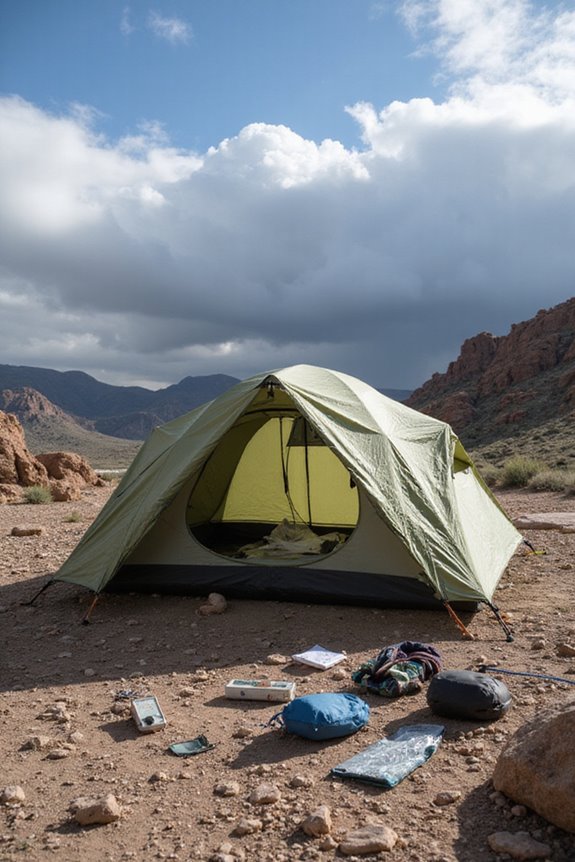
When planning our outdoor escapades, the weather can be our best friend or worst enemy. To keep our spirits high, we need to understand waterproof ratings. Tents with HH ratings of 1,000mm to 1,500mm are like flimsy umbrellas—great for a light drizzle but hopeless in a downpour. For three-season camping, we should look for 2,000mm to 3,000mm ratings that can handle typical weather patterns. If we’re eyeing those gnarly winter trips, high-end tents with 3,000mm to 5,000mm ratings are our best bet. Remember, a tent’s fabric and structure work together against the elements, so let’s not skimp on quality. Embrace freedom, take on the wild, but make sure we’re protected against whatever nature throws our way!
Exploring Additional Features for Comfort
Exploring additional features for comfort in our tents can turn a good camping trip into an unforgettable experience! Think about interior organization—built-in pockets and gear loops keep our essentials within reach, so we can focus on the adventure instead of digging through gear.
We can’t underestimate vestibule benefits, either! Those extra spaces are perfect for storing muddy boots or relaxing with a cup of coffee while admiring the view.
Let’s talk ventilation techniques—smartly placed vents and mesh walls keep airflow moving, reducing condensation on those damp nights. And with quality materials like sturdy poles and high-grade fabrics, our tents stay solid and cozy, even in unpredictable weather. Choosing wisely means more freedom on our outdoor journeys!
Choosing the Right Tent for Your Activity
How do we choose the right tent for our outdoor adventures? First, we consider our activity types. For camping and hiking, dome tents are fantastic for their stability and easy setup, fitting 2-3 of us snugly. If we’re going family-style, tunnel tents bring the roominess and comfort we crave.
For the wildest weather, geodesic tents hold strong against high winds. And when we’re trekking light, ultralight tents make our backs grateful! Don’t forget to factor in the tent features; good ventilation and waterproof ratings are essential for comfort.
Balancing size, weight, and durability keeps our adventures enjoyable. So, let’s choose wisely and embrace the freedom of the great outdoors!
Tips for Tent Setup and Maintenance
Setting up your tent can feel like a challenging task, but trust me, it doesn’t have to be! First, we’ve gotta find that perfect flat spot, avoiding rocks and slopes—no one wants a surprise puddle! Think about the wind direction, too; orient your tent door to face away from it for a calmer night’s sleep.
When it’s time to pitch, teamwork makes the dream work. With a buddy, we can smoothly assemble the poles and raise the tent! Don’t forget the groundsheet—a lifesaver for protecting our tent floor.
For maintenance tips, let’s clean our tent after adventures and store it loose to prevent mildew. Checking zippers and treating seams annually keeps our cozy outdoor haven in top shape!
Budgeting for Your Tent Purchase
After mastering the art of setting up and caring for our tents, it’s time to tackle the money side of things—budgeting for your tent purchase! Let’s get real: our budget allocation is vital. Entry-level tents start around $50, but for frequent adventures, consider quality options around $100 to $400.
It’s wise to evaluate rental costs too; a big gathering could push rental fees to a grand or more! If we’re camping often, investing in a solid tent is important—it’ll save us in the long run. Plus, don’t forget about extra gear costs! Overall, setting a budget that balances our needs with our outdoor dreams is essential for that sweet freedom we all crave. Let’s embrace it!
Frequently Asked Questions
What Are the Best Brands for Camping Tents?
When exploring the best brands for camping tents, we should consider tent features and brand comparisons. Brands like The North Face and REI Co-op offer spacious, durable options that support our adventurous spirit in various conditions.
How Do I Clean and Maintain My Tent?
Like gardeners tending to delicate blooms, we must nurture our tents. For tent storage, keep it dry and breathable, and for tent waterproofing, apply treatments regularly. This guarantees our adventures remain carefree and enjoyable under any sky.
Can Tents Be Repaired if Damaged?
Absolutely, we can repair our tents! With a proper damage assessment, we can choose the best tent repair method. By addressing issues promptly, we keep our adventures alive and our gear ready for freedom!
Are There Eco-Friendly Tent Options Available?
Absolutely, there’re eco-friendly tent options available! By choosing tents made from sustainable materials like recycled polyester and exploring tent recycling, we can enjoy the great outdoors while protecting our planet and embracing our adventurous spirit.
What Is the Lifespan of a Typical Camping Tent?
When we think about a typical camping tent’s lifespan, it’s influenced by tent durability factors and seasonal tent usage. With proper care, we can enjoy our tents for 5-10 years or even longer!

